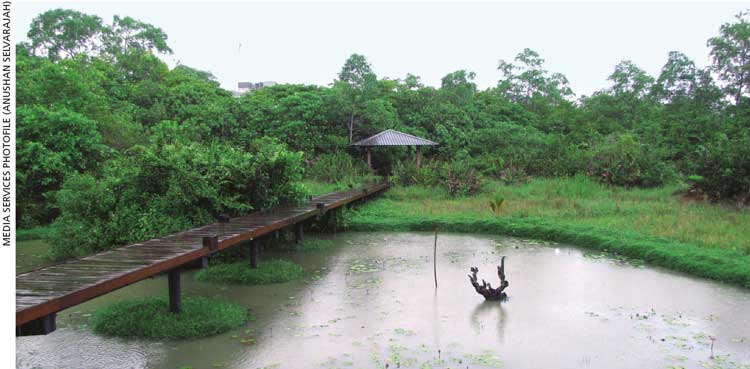BIOLOGICAL ASSETS
A TIMELY WETLAND WARNING
Roshini Galappatti heeds the gradual degradation of wetland habitats
Wetlands – more commonly known as marshes and mangroves – are an intrinsic element of Sri Lanka’s natural assets. In ecotourism, wetlands play a critical role by way of enriching ecological diversity, with many diverse ecosystems providing a sanctuary for flora and fauna. The richer the ‘bioassets,’ the greater the interest in a destination such as Sri Lanka, as the travel experience becomes more authentic.
The biodiversity of our wetlands is clearly characterized by the rich array of wetland ecosystem-habitat types, and the larger number of animal and plant species that they harbour. For example, the International Union for Conservation of Nature (IUCN) and Central Environment Authority’s joint publication, National Wetland Directory of Sri Lanka, states that amongst the inland vertebrate species in Sri Lanka, about 30 percent are ecologically dependent on wetlands.
Among the migratory birds that visit Sri Lanka annually, more than 50 percent are directly dependent on wetlands for shelter. Furthermore, the future survival of approximately 32 percent of the nationally threatened vertebrate faunal species in Sri Lanka is dependent on wetland ecosystems in the island.
Aside from being a hotbed of ecological activity, wetlands also play a critical role in flood prevention and surface water filtration. Urban wetlands such as the Bellanwila-Attidiya and Sri Jayewardenepura Kotte marshes, Madiwela mangroves and Battaramulla wetlands have been disturbed and reclaimed.
Flood prevention has been the rationale for the disruption of these natural habitats. However, wetlands, in their own right, are natural flood-prevention mechanisms – i.e. by holding water, much like a sponge. Wetlands also release vegetative matter into rivers, which helpfeed fish and other water-based fauna. They play a critical role in countering and balancing the human effect on rivers, by rejuvenating them and surrounding ecosystems.
Many animals that live in other habitats use wetlands for migration or reproduction. For example, herons nest in large, old trees, but need shallow areas to wade for fish and aquatic life. Amphibians often forage in upland areas, but return to the water to mate and reproduce.
Moreover, wetlands are not isolated or independent habitats. They are essentially symbiotic to other biomes, and to wildlife and humans, because wetlandsdirectly improve other ecosystems. Development of urban areas in the interest of tourism has, unfortunately, become one of the most significant intrusions to Sri Lanka’s wetlands.
Although protected under the Ramsar Convention, and despite falling under the Fauna and Flora Protection Ordinance of 1937, many urban wetlands in and around the nation’s commercial capital have been gravely intruded. Intense digging, removal of mangroves, and physical and biological transformation of wetlands – though adding to the physical beauty of the locations – have placed many eco-habitats in imminent danger.
The freshwater marshesof Bellanwila-Attidiya, Muthurajawela and Sri Jayewardenepura Kotte are protected wetlands under the supervision of the Department of Wildlife Conservation.
Most of the area surrounding the Parliament complex in Sri Jayewardenepura Kotte consists of low-lying freshwater marshlands, a key feature of local topography. The Beddagana urban wetland, a part of the flood plains of the Diyawanna Oya, has been a birds’ paradise for decades. Habitats as diverse as ponds studded with water lilies, wet shrub lands, seasonally flooded grasslands and mud flats are found in this vicinity.
The Beddagana wetland is a scenic bird-watcher’s paradise – 18 migrant bird species and 34 resident species can be identified in the area. Yet, the destruction of these natural assets has been grave, and the effects of the man-made changes to an ancient ecosystem will be far-reaching.
Likewise, between 1998 and 2006, the Bellanwila Attidiya sanctuary has lost most of its diversity, with as much as a 40 percent reduction in the faunal assemblage.
However, the reduction in bio-assets since 2006 has not been gauged.
Rapid destruction of the marsh and mangrove in the Bellanwila-Attidiya sanctuary over the past year, due to development work and aesthetic beautification of the urban surroundings, means that the faunal assemblage would have drastically reduced since the last audit.
The future sustenance of inland wetlands and their biological resources, in the context of increasing allocation of wetland and water resources for a growing human population, is a challenge that needs to be addressed speedily, yet wisely.
Conservation biologists and environmentalists need to work in close collaboration with development planners and policymakers, to find viable solutions to the these challenges that would play a decisive role in the future conservation of inland freshwater wetlands in Sri Lanka.




